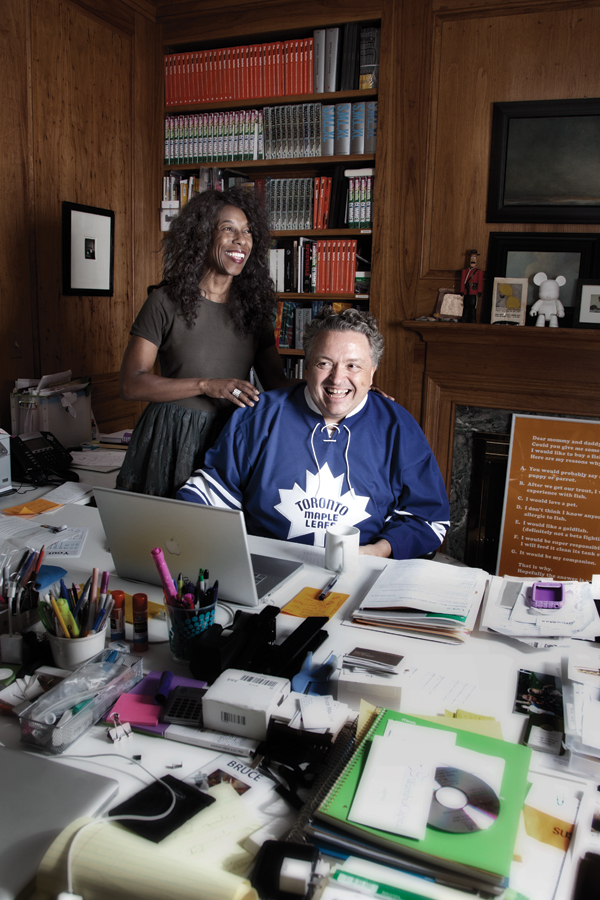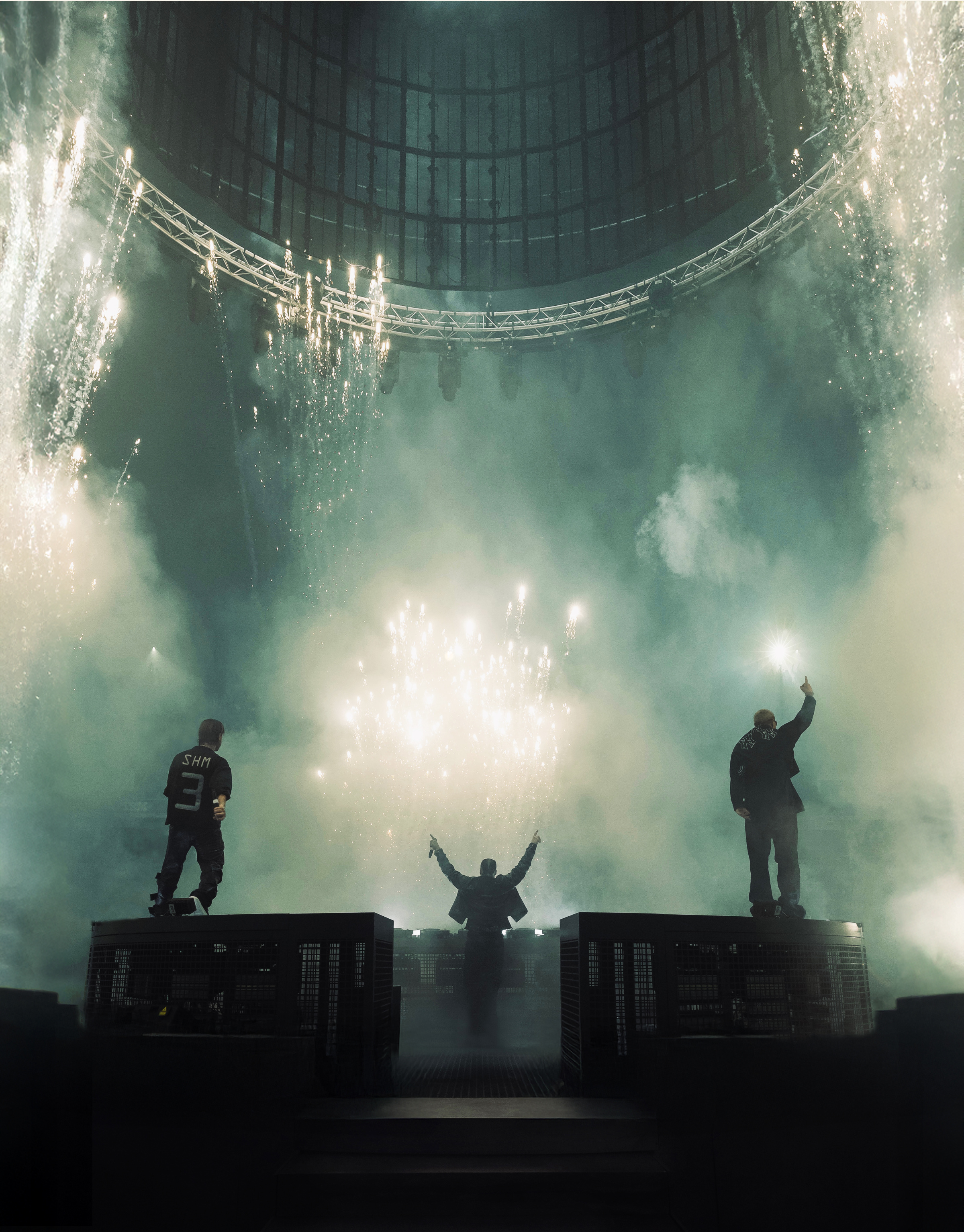Most designers build their careers through specialization. They choose one area of the graphic world and spend decades perfecting projects and honing their expertise in that area. Although this approach is perfectly acceptable and considered the norm for most in this practice, it just doesn’t fit the mindset of designer Bruce Mau.
Mau, a native Canadian now based in the US, thrives on versatility. He first became known for his revolutionary graphic design work on the Zone Books for MIT Press, in which he created a cohesive graphic identity for the series that broke free from traditional book layouts. He also became the graphic force behind SMLXL, architect Rem Koolhaas’ seminal architecture tome. Outside of books, Mau’s graphic work earned him heavy hitting jobs, including designing the entire signage systems for architect Frank Gehry’s Disney Concert Hall and Koolhaas’ iconic Seattle Public Library. Other more recent career coups included his work on ¡GuateÁmala!, the Guatemalan government’s expansive communications campaign to reinvigorate national pride, and Massive Change, an exhibit that used graphics and media to pinpoint design thinking as an approach to breaking down systemic world problems. He has since expanded this idea of Massive Change into new research practices, making the exhibit one of his most defining works.
Such a prolific career spanning more than 25 years would be enough to overinflate any designer’s ego, but refreshingly, Mau hasn’t transformed into a design egoist. Rather, he is warm, welcoming and jovial, walking to greet Zoë Ryan, curator of Architecture and Design at the Art Institute of Chicago, as she arrives on a North Shore-bound train for her interview with Mau at his home. He greets his friend with a toothy smile and a wave hello.
His house is just as inviting as his wide grin. A conversation with both Mau and his vivacious wife Bisi reveals that they worked hard to transform the house from a dark, wood-covered box into a bright, airy home for their brood. Playful elements like family photos, a poster-sized plea for a pet fish from his daughter and a giant trampoline in the front yard make his space far from curated. It’s the perfect habitat to breed creativity and curiosity—and new ventures.
As it turns out, Mau recently took a step back from his duties at the revered studio Bruce Mau Design to begin a new one, Bruce Mau Live. Its mission: to broadly improve the world through his theory of Massive Change. Its current number of employees: two, just Bruce and Bisi. Without many hands on deck, most people would find such an all-encompassing goal entirely overwhelming. But not Mau. Armed with decades of design experience and unwavering optimism, he is funneling all his efforts into Bruce Mau Live and the idea of Massive Change, a strategy he’s hoping will help resolve some of the world’s biggest issues.
Here is a portion of the conversation Mau had with Ryan for Design Bureau, in which he explains just how he plans to solve such major problems with his new design thinking firm and theory—and how he will do it all while maintaining his positive approach and signature broad smile.
Design has changed its place in the world, from a subset of business to the biggest business of all.
–Bruce Mau
Zoë Ryan: Bruce, what do you feel is your responsibility as a designer?
Bruce Mau: The way that I’ve been thinking about design for quite a long time is that it’s constantly evolving. I think that there are roles, possibilities, opportunities, and responsibilities in each system. I think [that] this moment in time is a moment of struggle. For me, personally, for the world, for the [design] work. There’s a struggle going on.
ZR: It’s interesting to hear you say, “I’m struggling because the world’s struggling.” Has this experience prompted you to focus the work of your studio more directly on projects that have social significance and meaning? Are the outcomes of these projects the reason you remain so optimistic?

Bruce Mau by Jane J. Gaspar
BM: I have a fact-based optimism. We live in a world of six billion people, and we wouldn’t be here if we weren’t winning. If we were losing, we would be a billion. We won, and we’re closing in on seven billion. Now that’s creating a whole craft of troubles that we wouldn’t have if we weren’t successful. We wouldn’t have climate change. If there were only a billion of us, every one of us could drive a Cadillac and it wouldn’t matter. We’ve overcome such incredible problems, and we’ve done it by distributing power. The reality of our culture is that we’re social, and we distribute capacity. We teach people — that’s the whole idea of education. Think about it—it’s an idea that says, “I’m going to help you.” We put that at the foundation of our culture, so it has had an amazing effect on society. So optimism is based on reality; if you’re pessimistic, then you’re actually suffering from a disorder. If you only focus on the negative, it’s paralyzing—it doesn’t inspire you. You go home, you go to bed, you lock your door. And so [pessimism] produces negative effects, which is why I think this is such an important question: Can we generate optimism and can we generate movement forward?
ZR: How then do you see your role as a designer?
BM: That’s a really good question. The easy answer is that there’s a variable. Sometimes I act as an instigator—I can help you look at problems, I can show you solutions, and then you’re going to fix it. For example, I’m not going to fix Guatemala, the people of Guatemala are going to fix Guatemala. I can help them communicate what they want to fix and then they can go ahead and do their thing.
ZR: But isn’t the idea behind Massive Change that a collective response—in which teams of people with different knowledge and skills are brought together to solve problems rather than an individual response—can achieve stronger outcomes? How then does a collective message get put forward in order to achieve projects that have strong voices?
BM: I work really hard, and if I’m going to work really hard, then I want to know that the work I’m doing is good. When I was working for a corporate design firm, I had this feeling that I was building my own prison. It wasn’t a good feeling. I was constraining life rather than releasing it.
ZR: What was the impetus for your move to America?
BM: This was “the empire.” When you go to Canada, the conversation is all academic. It’s not real in the sense that you don’t have a responsibility for anything. We’re good at talking, but we don’t actually have to decide when to pull the trigger. We don’t have to decide whether or not we will enforce international law. The reality is that America has that role. Every conversation is intense because the outcome is real. The outcome is: “We’re going to spend billions of dollars on this or that, we’re going to go support this, and we’re going to take money away from that.” If America does things, it impacts the global economy; it has a central role in the discourse of the world. It’s not that marginal discourses aren’t important—they can all affect the central discourse—but being here, you’re connected to people who have the capacity to do things.
ZR: What has been most surprising or eye-opening to you about moving here?
BM: I thought I knew America—our biggest clients are here in America. But what I realized is that I was actually working with Canadian Americans. The kind of people who hire me, they are not the total bandwidth of experience. The Getty Center, Frank Gehry, MoMA — these are not your typical American people.
ZR: Since moving to Chicago, you have become involved in a number of local initiatives and projects. Recently, you became a member of the Herman Miller design council. What has been your experience of working with this company?
Any bonehead can make a thousand-dollar product. Try making it for $150. That takes the best design.
BM: It’s been an absolutely extraordinary experience. They’ve started thinking about [total] design rather than thinking [only] about the products as design.In general, when we first think about low-cost products, we think that we’re going to have to go down-market. But at Herman Miller, we’re thinking about it as flipping design upside down and saying that the lower cost product is the best achievement of design. Any bonehead can make a thousand dollar product. Try making it for $150. That takes the best design, and it’s the highest order accomplishment because that means we’re using less energy, we’re using fewer resources, and we’re producing the most effect. If you can design in the spirit of Herman Miller, then you have contributed to the world of positive effects. For me, that definition of design as thinking about the whole enterprise as a design enterprise is a perfect engagement.
ZR: Your latest venture is that of Bruce Mau Live. What does this mean for your role within your own studio in Toronto? Has Bruce Mau left Bruce Mau Design?
BM: I will still do key projects. Hunter Tura, the CEO [of Bruce Mau Design], talks about spike projects—projects that spike the capacity of the studio; those I’m [still] involved in. If you want to get a book done, one of the best places in the world to do that is BMD. Now, if you want to do a book that goes to new places, that inspires me, then that I’ll be involved with.
ZR: So how will Bruce Mau Live differ?
BM: [BML] develops new things; it’s not for a client. We know that education is a key area of focus [for us]. We need to do a new way of thinking about education. If you can accelerate that, then you can accelerate everything else. That’s not what a design studio is set up to do. It has an infrastructure to deliver excellent design services and very creative work for design projects.
ZR: Will Bruce Mau Live be more research-oriented? Will you work on more self-initiated projects?
BM: Yes. I realized that in the past I was interested in doing both of those things, and it was totally confusing to people. I would throw that into the studio, and because I was excited, everybody would want to be involved. There would be a research project with like a $25 budget, no money behind it, and yet when I would go give a presentation about it, there would be half a dozen people there from the studio because they saw that I was really excited.
ZR: Is this a new business model that you are instigating for a design practice?
BM: You have to design research as a business. You don’t have to as much as you need to. Massive Change is obviously a huge change in the way I work and think. It’s about getting at the real problem, getting at a central idea, and I think that’s the real transformation. The thing that is interesting about it is that when you use the word “design,” most people think “fancy, expensive, singular objects.” They think cultural, not popular. They think it’s expensive. They think it’s singular—an authored thing. What we realized is that, for our work, those are old definitions and categories. We’re looking at plural, systematic, economic and ecological things. How do we make collective things that are systematic, that produce beauty and quality, and can produce that beauty and quality economically, ecologically and in perpetuity? That’s a new way to think about design.
ZR: But you are talking about a complete rethinking of how a design practice can function, am I correct?
BM: If you think about design in the old way, you think, “Oh, that Bruce Mau, he’s a megalomaniac. He wants to design the world.” I think the “designer idea” is still very much tied to an authorship, a singular artist, whereas this is about collaboration.
The world still wants a narrative, and how we deal with stories is changing. You know, we tell stories to talk about an idea. When I was in New York, I went to hear Bill Clinton. And he was amazing, but he was boring—all he talked about was math. And for a wonk like me, I get excited. But everybody else is like, “This is so dull because it doesn’t touch my narrative heart, and I can’t tell my story.” So getting to the collective things and getting to a way that allows people to tell individual narratives is what I think we’re about.
Design has changed its place in the world, from a subset of business to the biggest business of all. In the end, we’re not going to win by being right or smart—we know how to be right and smart, we’ve known that for 40 or 50 years. It’s a really hard subject for people because we like to act like we don’t have responsibility. We have it, but we act like we would rather not. We would rather that the world just happen to us. But designers don’t have that luxury. When we say that nature is now a design problem, we’re not saying that it would be fun to mess with nature. We’re actually saying, “You have a responsibility to the world that you love.” Essentially, it’s about understanding that responsibility and accepting it: we’re going to have to design nature, or we will perish.
ZR: Bruce, have we missed anything in terms of defining this new direction for you with regards the founding of Bruce Mau Live?
BM: Well, the one thing that’s not so clear is the economic mechanism. The real problem is that we don’t know how to do it yet, but we do know that it is possible to do. Ultimately, a very narrow sliver of people can afford to be in some kind of emergent experience in Chicago, or Toronto, or anywhere else. The people who need Massive Change the most are completely cut out of that. So, one of the things that we’re committed to is this idea that we need a new currency. Imagine you’re a shareholder of a school that you’re part of. Rather than paying tuition, you would buy shares. That would mean that you would actually participate in the creative contribution that you’re making and the effect that it has. This is the real work, and we need to make an easy model to do it. I think this is such a critical idea: we need a currency that has an exchange rate with dollars.
ZR: But isn’t the challenge being able to make visible the value—financial, social and cultural—of this work?
BM: All great design has value, great reputational value. When we went to South Africa, we announced that we wanted to do something about Massive Change. And there was a line around the hall, hundreds and hundreds of people who wanted to do it. And it’s like, “Oh, Wow! Ok…we better figure out what to do. How are we going to do this?” These people can see it’s the new way, so how can we make it easy for them? How can they be part of this?
The real challenge is to change the story from hard to easy. To do what we’re talking about, if it’s hard, it will be very exclusive. Design needs to just be easy, but it’s so difficult to achieve. So figuring out the easy concepts in design is our major challenge.
Introduction by Kathryn Freeman Rathbone
Q&A by Zoë Ryan
Photos by Jane J. Gaspar
(via Design Bureau 2011)



